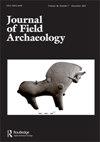Household Labor Practices and Dryland Agroforestry in Upland Kula, Maui Island
IF 1.5
1区 历史学
0 ARCHAEOLOGY
引用次数: 0
Abstract
ABSTRACTThe relationship between agricultural systems and the development of complex societies in ancient Hawai`i has been debated for decades. To contribute to this debate, we examine a terrace complex representing an extended family agricultural land plot in the Kula dryland field system of East Maui, Hawaiian Islands. Botanical, faunal, soil, and architectural analysis data reveal a variety of household labor practices related to agroforestry ca. a.d. 1400–1820. A pre-human open forest soil substrate was replaced with stone agricultural terracing which was in turn enclosed by upslope-downslope garden walls that parceled the terrace complex into distinct garden areas. These results lead us to conclude that a wide range of specialized upland activities were practiced, including food cultivation, forestry, pig husbandry, and bird-hunting. The net sum of these local activities helped underpin the formative process of larger regional-level agricultural systems which in turn can inform us about polity-level staple and wealth finance systems.KEYWORDS: Agriculturehuman-environmental interactionBayesian modelpig husbandrybirding huntingHawai`i AcknowledgementsWe would like to express our gratitude to our colleague and former supervisor Ross Cordy, Professor of Hawaiian-Pacific Studies at the University of Hawai`i West O`ahu, for his valuable input and guidance in the development of this research project. We express our thanks to Tom Dye, Noa Kekuewa Lincoln, and two anonymous reviewers for their constructive comments on this manuscript. Fieldwork was conducted in 1994 and 1995 under the auspices of the State of Hawaii Department of Hawaiian Home Lands as part of its mandate to develop and deliver lands to native Hawaiians. We would also like to thank Jane Allen, David Addison, Linda Scott Cummings, Patrick Kirch, Gail Murakami, Jade Moniz Nakamura, Jenny O'Clary, Tracy Tam Sing, and the late Alan Ziegler and Stoors Olsen for sharing their professional expertise. We also extend our sincere appreciation to the 1994 crew of the University of Hawai`i Kēōkea Archaeological Field School: Brock Adamchak, Stephanie Allen, Don Coloma, Karen Gulick, William (Koa) Hodgins, Lori Johnson, Kate Mortellaro, Amy Kaawaaloa, Erika Radewagen, Carter Richardson, Vincent Sava, Jacqueline Skeet, Kirsten Stromgren, and Cynthia Taylor.Disclosure StatementThe authors report there are no competing interests to declare.Additional informationFundingThis work was funded by the Department of Hawaiian Home Lands, the Hawai`i Department of Land and Natural Resources, and the 1994 University of Hawai`i Kēōkea Archaeological Field School.Notes on contributorsMichael J. KolbMichael J. Kolb (Ph.D. 1991, UCLA) is Professor of Anthropology at Metropolitan State University and Presidential Teaching Professor Emeritus at Northern Illinois University. His research focuses on ancient and historical political economies and the building of monumental architecture. He has published, amongst other things, on the labor energetics in medieval Sicily, prehistoric Europe, and Oceania. His most recent book is Making Sense of Monuments (London 2020).Patty J. ContePatty J. Conte (M.A. 1998, Northern Illinois University) is an archaeologist at Navy Facilities Engineering Systems Command (NAVFAC) Headquarters in Washington, DC. Her professional portfolio includes having worked at the Hawaii State Department of Land and Natural Resources State Historic Preservation Division from 1991–2001 and 2008–2010, NAVFAC Pacific, and the Department of the Army, as well as formerly providing independent archaeological consultant services in the state of Hawai`i.Valerie CurtisValerie Curtis (M.A. 2007, University of Hawai`i) is the US Air Force subject matter expert on cultural resources in Asia in the Pacific. She has over 30 years’ experience in this area. Her area of focus is on cultural resource management and historic preservation laws and regulations. Academic interests include paleoenvironmental reconstruction and human impacts to the environment.Jim HaydenJim Hayden (B.A./B.S. 1990, Purdue University) is the GIS Analyst at the Department of Planning and Permitting, City & County of Honolulu. He was an archaeologist at the Hawai`i State Department of Land and Natural Resources Historic Preservation Division at the time of this research.毛伊岛库拉高地的家庭劳动实践与旱地农林业
摘要古代夏威夷农业系统与复杂社会发展之间的关系已经争论了几十年。为了促进这一争论,我们研究了夏威夷东毛伊岛库拉旱地系统中一个代表扩展家庭农业用地的梯田综合体。植物、动物、土壤和建筑分析数据揭示了大约公元1400-1820年与农林业有关的各种家庭劳动实践。原始的开放森林土壤基质被石头农业梯田所取代,而这些梯田又被上下斜坡的花园墙所包围,将露台综合体包裹成不同的花园区域。这些结果使我们得出结论,他们从事广泛的专门的高地活动,包括粮食种植、林业、养猪和狩猎。这些地方活动的总和帮助支撑了更大的区域一级农业系统的形成过程,而这反过来又可以使我们了解政治层面的主食和财富融资系统。关键词:农业;人与环境相互作用;贝叶斯模型;养猪业;观鸟狩猎;夏威夷致谢我们要感谢我们的同事和前导师,夏威夷西奥胡岛大学夏威夷太平洋研究教授Ross Cordy,他在本研究项目的发展中提供了宝贵的意见和指导。我们对Tom Dye、Noa Kekuewa Lincoln和两位匿名审稿人对本文提出的建设性意见表示感谢。1994年和1995年,在夏威夷州国土部的主持下进行了实地调查,作为其开发和向夏威夷土著提供土地的任务的一部分。我们还要感谢简·艾伦、大卫·艾迪生、琳达·斯科特·卡明斯、帕特里克·基尔奇、盖尔·村上、杰德·莫尼兹·中村、珍妮·奥克莱里、特雷西·谭辛以及已故的艾伦·齐格勒和斯托尔斯·奥尔森分享他们的专业知识。我们也衷心感谢1994年夏威夷大学Kēōkea考古田野学校的工作人员:布洛克·亚当查克、斯蒂芬妮·艾伦、唐·科洛马、凯伦·古利克、威廉·哈金斯、洛里·约翰逊、凯特·莫特拉罗、艾米·卡瓦洛阿、埃里卡·拉德瓦根、卡特·理查森、文森特·萨瓦、杰奎琳·斯基特、克尔斯滕·斯特伦和辛西娅·泰勒。声明作者报告无竞争利益需要申报。这项工作由夏威夷国土部、夏威夷土地和自然资源部以及1994年夏威夷大学Kēōkea考古田野学校资助。作者简介michael J. Kolb michael J. Kolb(1991年毕业于加州大学洛杉矶分校)是大都会州立大学人类学教授和北伊利诺伊大学名誉校长教学教授。他的研究主要集中在古代和历史的政治经济和纪念性建筑的建设。他的著作包括中世纪西西里岛、史前欧洲和大洋洲的劳动能量学。他最近的一本书是《古迹的意义》(2020年伦敦)。Patty J. Conte(1998年硕士,北伊利诺伊大学)是华盛顿特区海军设施工程系统司令部(NAVFAC)总部的考古学家。她的专业组合包括1991-2001年和2008-2010年在夏威夷州土地和自然资源部、州历史保护部、NAVFAC太平洋和陆军部工作,以及以前在夏威夷州提供独立考古顾问服务。瓦莱丽·柯蒂斯瓦莱丽·柯蒂斯(2007年夏威夷大学文学硕士)是美国空军在亚洲和太平洋地区文化资源方面的主题专家。她在这个领域有超过30年的经验。她的研究领域是文化资源管理和历史保护法律法规。主要研究方向为古环境重建和人类对环境的影响。吉姆·海登(文学学士/理学士1990年,普渡大学)是檀香山市和县规划和许可部门的地理信息系统分析师。在进行这项研究时,他是夏威夷州土地和自然资源部历史保护司的一名考古学家。
本文章由计算机程序翻译,如有差异,请以英文原文为准。
求助全文
约1分钟内获得全文
求助全文
来源期刊

JOURNAL OF FIELD ARCHAEOLOGY
ARCHAEOLOGY-
CiteScore
4.60
自引率
5.30%
发文量
29
期刊介绍:
The Journal of Field Archaeology is an international, refereed journal serving the interests of archaeologists, anthropologists, historians, scientists, and others concerned with the recovery and interpretation of archaeological data. Its scope is worldwide and is not confined to any particular time period. Contributions in English are welcomed from all countries.
 求助内容:
求助内容: 应助结果提醒方式:
应助结果提醒方式:


